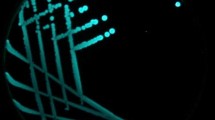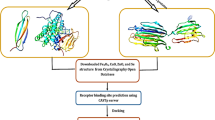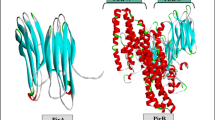Abstract
Grow-out and hatchery units of shrimps are being impacted by disease-causing bacterial pathogens and predominantly marine Vibrios. The use of chemicals for governing bacterial pathogens in the aquaculture practices is developing resistance to bacteria. Henceforth, the application of bio-therapeutic agents from marine resources for controlling pathogens is most vital to be considered. Molecular docking is computer-assisted drug design tool to detect and counteract for drug–receptor interaction for known target protein of diseases. Therefore, an effort was made with the extract of the marine micro alga Skeletonema costatum against hemolysin protein of pathogenic bacteria Vibrio harveyi. The extract of S. costatum was tested against growth and virulence produced by V. harveyi during larviculture of Penaeus monodon. The extract was analyzed for phyto-constituents through GC–MS and used them as ligand molecule in docking. S. costatum extract at 200 µg mL−1 was found to decrease 35.20% of cumulative percentage mortality (CPM) in postlarvae of P. monodon against V. harveyi infections. The biomolecule Docasane, an alkane from the extract of S. costatum, exposed highest binding interaction than other compounds during docking analysis. The level of significance (P < 0.05) was found in CPM, growth, and virulence factors of V. harveyi studies. Thus, the present finding predicts that extract of S. costatum containing biomolecules can be recommended for use in the shrimp culture-based grow-out and hatchery units for eliminating bioluminescent V. harveyi.



Similar content being viewed by others
References
Mandal A, Das SK (2018) Comparative efficacy of Neem (Azadirachta indica) and in—neem supplemented bio-floc media in controlling the harmful luminescent bacteria in natural pond culture of Penaeus vannamei. Aquaculture 492:157–163. https://doi.org/10.1016/j.aquaculture.2018.04.006
Ma S, Kim A, Lee W, Kim S, Lee S, Yoon D, Bae JS, Park CI, Kim S (2020) Vibrio harveyi infection significantly alters amino acid and carbohydrate metabolism in whiteleg shrimp, Litopenaeus vannamei. Metabolites 10(6):265. https://doi.org/10.3390/metabo10060265
Ruwandeepika HAD, Jayaweera TSP, Bhowmick PP, Karunasagar I, Bossier P, Defroidt T (2012) Pathogenesis, virulence factors, and virulence regulation of Vibrios belonging to the Harveyiclade. Rev Aquacult 4(2):59–74. https://doi.org/10.1111/j.1753-5131.2012.01061
Stalin N, Srinivasan P (2016) Molecular characterization of antibiotic-resistant Vibrio harveyi isolated from shrimp aquaculture environment on the southeast coast of India. Microb Pathog 97:110–118. https://doi.org/10.1016/j.micpath.2016.05.021
Zhong Y, Zhang XH, Chen J, Chi Z, Sun B, Li Y, Austin B (2006) Over expression, purification, characterization, and pathogenicity of Vibrio harveyi hemolysin VHH. Infect Immun 74(10):6001–6005. https://doi.org/10.1128/IAI.00512-06
Sivakumar K, Kannappan S, Dineshkumar M, Patil PK (2014) Antagonism of marine macro alga Kappaphycus alvarezii extract against luminescence disease causing Vibrio harveyi during Penaeus monodon larviculture. Afr J Microbiol Res 8:458–469. https://doi.org/10.5897/AJMR2013.6232
Velmurugan S, Punitha SMJ, Babu MM, Selvaraj T, Citarasu T (2010) Indian herbal medications to replace antibiotics for shrimp Penaeus monodon postlarvae. J Appl Aquacult 22(3):230–239. https://doi.org/10.1080/10454438.2010.500589
Traifalgar RF, Serrano AE, Corre V, Kira H, Tung HT, Fady RM, Kader MdA, Laining A, Yokoyama S, Ishikawa M, Koshio S (2009) Evaluation of dietary fucoidan supplementation effects on growth performance and Vibriosis resistance of Peneaus monodon postlarvae. Aquacult Sci 57(2):167–174. https://doi.org/10.11233/aquaculturesci.57.167
Wong SL, Liu CH, Cheng W, Yeh SP (2008) Improved survival under Vibrio challenge and enhanced immune gene transcription of the pacific white shrimp, Litopenaeus vannamei, which were orally administrated with brown algae extract, Endarachne binghamiae. J Fish Soc Taiwan 35(1):17–34. https://doi.org/10.29822/JFST.200803.0002
Kannappan S, Sivakumar K, Patil PK (2013) Effect of garlic extract on the luciferase, bio-luminescence, virulence factors produced by Vibrio harveyi with a challenge during Penaeus monodon larviculture. Afr J Microbiol Res 7(18):1766–1779. https://doi.org/10.5897/AJMR/12.950
Sivakumar K, Kannappan S (2013) Inhibitory effect of marine algae collected from the East and West coast of India against luciferase and luminescence producing Vibrio harveyi. Afr J Biotechnol 12(22):3493–3502. https://doi.org/10.5897/AJB2013-12376
Wu J, Alam MA, Pan Y, Huang D, Wang Z, Wang T (2017) Enhanced extraction of lipids from microalgae with eco-friendly mixture of methanol and ethyl acetate for biodiesel production. J Taiwan Inst Chem Eng 71:323–9
Almeida B, Barroso S, Ferreira AS, Adao P, Mendes S, Gil MM (2021) Seasonal evaluation of phlorotannin-enriched extracts from brown macro algae Fucus spiralis. Molecules 26(14):4287. https://doi.org/10.3390/molecules26144287
Little SM, Senhorinho GN, Saleh M, Basiliko N, Scott JA (2021) Antibacterial compounds in green microalgae from extreme environments: a review. Algae 36(1):61–72. https://doi.org/10.4490/algae.2021.36.3.6
Sahoo RN, Pattanaik S, Pattnaik G, Mallick S, Mohapatra R (2022) Review on the use of molecular docking as the first line tool in drug discovery and development. Ind J Pharmaceut Sci 84(5):1334–1337. https://doi.org/10.36468/pharmaceutical-sciences.1031
Morris GM, Lim-Wilby M (2008) Molecular docking. Methods MolBiol 443:365–382. https://doi.org/10.1007/978-1-59745-177-2_19
Bordoli L, Kiefer F, Arnold K, Benkert P, Battey J, Schwed T (2009) Protein structure homology modelling using SWISS-MODEL workspace. Nat Protoc 4:1–13. https://doi.org/10.1038/nprot.2008.197
Wisastra R, Kok PA, Eleftheriadis N, Baumgartner MP, Camacho CJ, Haisma HJ, Dekker FJ (2013) Discovery of a novel activator of 5-lipoxygenase from an anacardic acid derived compound collection. Bioorg Med Chem 21(24):7763–7778. https://doi.org/10.1016/j.bmc.2013.10.015
Prartono T, Kawaroe M, Katili V (2013) Fatty acid composition of three diatom species Skeletonema costatum, Thalassiosira sp. and Chaetoceros gracilis. Int J Environ Bioenergy 6(1):28–43
Smith VJ, Desbois AP, Dyrynda EA (2010) Conventional and unconventional antimicrobials from fish, marine invertebrates, and microalgae. Mar Drugs 8(4):1213–1262. https://doi.org/10.3390/md8041213
Shanmugapriya R, Ramanathan T (2011) Screening for antimicrobial activity of crude extracts of Skeletonema costatum. J Appl Pharm Sci 1(07):154–157
Maiti B, Malathi S, Rekha K, Karunasagar I, Karunasagar I (2009) Evaluation of RAPD-PCR and protein profile analysis to differentiate V harveyi strains prevalent along the Southwest coast of India. J Genet 88(3):273–279. https://doi.org/10.1007/s12041-009-0040-z
Guillard RRL, Ryther JH (1962) Studies on marine planktonic diatoms I. Cyclotella nana Hustedt and Detonula confervacae (Cleve) Gran. Can J Microbiol 8:229–239
Saeed U, Waheed Y, Anwar A, Hussain T, Naeem K, Nawaz N, Farrukh F, Qadri I (2011) In-silico binding of ATP to protein kinase C Delta: insights into the structure and active site. Eur J Sci Res 52(2):177–187
Sivakumar K, Kannappan S, Vijayakumar B, Jithendran KP, Balasubramaniam S, Panigrahi A (2021) Molecular docking study of bio-inhibitors extracted from marine macro-alga Ulva fasciata against hemolysin protein of luminescence disease-causing Vibrio harveyi. Arch Microbiol 203(7):4243–58. https://doi.org/10.1007/s00203-021-02408-1
Parasuraman S, Raveendran R, Vijayakumar B, Velmurugan D, Balamurugan S (2012) Molecular docking and ex-vivo pharmacological evaluation of constituents of the leaves of Cleistanthus collinus (Roxb) (Euphorbiaceae). Ind J Pharmacol 44(2):197–203. https://doi.org/10.4103/0253-7613.93848
Vanden Berg B (2010) Crystal structure of a full-length auto-transporter. J Mol Biol 396(3):627–633. https://doi.org/10.1016/j.jmb.2009.12.061
Rao BM, Inman F III, Holmes L, Lalitha VK (2012) Chitinase production in fed-batch fermentation of colloidal chitin using a mixed culture of Vibrio harveyi and V. alginolyticus. Fishery Technol 50:66–74
Akifume O, Takahashi O (2009) Validation of Argus Lab efficiencies for binding free energy calculations. ChemBio-Inform J 9:52–61
Turgeson AW, Giles DK, Harris BJ (2022) Simulated docking reveals putative channels for the transport of long-chain fatty acids in Vibrio cholerae. bioRxiv. https://doi.org/10.1101/2022.01.26.477967
Lounnas V, Ritschel T, Kelder J, McGuire R, Bywater RP, Foloppe N (2013) Current progress in structure-based rational drug design marks a new mind set in drug discovery. Comput Struct Biotechnol J 5(6):e201302011. https://doi.org/10.5936/csbj.201302011
Thompson JR, Cronin B, Bayley H, Wallace MI (2011) Rapid assembly of a multimeric membrane protein pore. Biophys J 101(11):2679–2683. https://doi.org/10.1016/j.bpj.2011.09.054
Madeswaran A, Umamaheswari M, Asokkumar K, Sivashanmugam T, Subhadradevi V, Jagannath P (2012) Discovery of potential aldose reductase inhibitors using in silico docking studies. Orient Pharm Exp Med 12(2):157–161. https://doi.org/10.1007/s13596-012-0065-3
Madeswaran A, Umamaheswari M, Asokkumar K, Sivashanmugam T, Subhadradevi V, Jagannath P (2011) In-silico docking studies of lipoxygenase inhibitory activity of commercially available flavonoids. J Comput Methods Mol Des 1:65–72
Shankar KG, Fleming AT, Vidhya R, Nirmal S (2013) In-silico anticancer activity of cow urine extract of Kappaphycus alvarezii. Int J Novel Trends Pharm Sci 3(5):106–110
Naviner M, Berge JP, Durand P, Le Bris H (1999) Antibacterial activity of the marine diatom Skeletonema costatum against aquacultural pathogens. Aquaculture 174(91):15–24
Rico-Mora R, Voltolina D, Villaescusa-Celaya JA (1998) Biological control of Vibrio alginolyticus in Skeletonema costatum (Bacillariophyceae) cultures. Aquacult Eng 19(1):1–6. https://doi.org/10.1016/S0144-8609(98)00035-1
Ribalet F, Intertaglia L, Lebaron P, Casotti R (2008) Differential effects of three polyunsaturated aldehydes on marine bacterial isolates. Aqua Toxicol 86:249–255. https://doi.org/10.1016/j.aquatox.2007.11.005
Bergsson G, Hilmarsson H, Thormar H (2011) Antibacterial, antiviral, and antifungal activities of lipids. In: Thormar H (ed) Lipids, and essential oils as antimicrobial agents. Wiley, Chichester, pp 47–80
Selvin J, Manilal A, Sujith S, Kiran GS, Lipton AP (2011) Efficacy of marine green alga Ulvafasciataextract on the management of shrimp bacterial diseases. Latin Am J Aquat Res 39(2):197–204. https://doi.org/10.3856/vol39-issue2-fulltext-1
Pestana-Nobles R, Aranguren-Díaz Y, Machado-Sierra E, Yosa J, Galan-Freyle NJ, Sepulveda-Montano LX, Kuroda DG, Pacheco-Londono LC (2022) Docking and molecular dynamic of microalgae compounds as potential inhibitors of Beta-Lactamase. Int J Mol Sci 23(3):1630. https://doi.org/10.3390/ijms23031630
Sun B, Zhang XH, Tang X, Wang S, Zhong Y, Chen J, Austin B (2007) A single residue change in Vibrio harveyi hemolysin results in the loss of phospholipase and hemolytic activities and pathogenicity for turbot (Scophthalmus maximus). J Bacteriol 189(6):2575–2579
MouraLA SEF, Bianco EM, Pereira RC, Teixeira VL, Fully AL (2011) Antiophidian properties of a dolostone diterpene isolated from the marine brown alga Canistrocarpus cervicornis. Bio-Med Prev Nutr 1(1):61–66. https://doi.org/10.1016/j.bionut.2010.09.003
Soltani S, Ebrahimzadeh MA, Khoshrooei R, Rahmani Z (2012) Antibacterial and antihemolytic activities of Enteromorphaintestinalis in the Caspian Sea Coast. Iran J Med Plants Res 6(3):530–533. https://doi.org/10.5897/JMPR11.1462
Costa RM, Magalhaes AS, Pereira JA, Andrade PB, Valentao P, Carvalho M, Silva BM (2009) Evaluation of free radical-scavenging and anti-hemolytic activities of quince (Cydoniaoblonga) leaf: a comparative study with green tea (Camellia sinensis). Food Chem Toxicol 47(4):860–865. https://doi.org/10.1016/j.fct.2009.01.019
Munawaroh HS, Gumilar GG, Nurjanah F, Yuliani G, Aisyah S, Kurnia D, Wulandari AP, Kurniawan I, Ningrum A, Koyande AK, Show PL (2020) In-vitro molecular docking analysis of microalgae extracted phycocyanin as an anti-diabetic candidate. Biochem Eng J 161:107666. https://doi.org/10.1016/j.bej.2020.107666
Sumathy R, Sankaranarayanan S, Bama P, Ramachandran J, Vijayalakshmi M, Deecaraman M (2013) The antioxidant and antihemolytic activity of flavonoid extract from the fruit peel of Punica granatum. Asian J Pharm Clin Res 6(2):11–214
Divya N, Nagamani J, Suma P (2012) Antioxidant and antihemolytic activities of Bombax ceiba pentandra spike and fruit extracts. Int J Pharm Pharm Sci 4(5):311–315
Arunkumar M, Mahalakshmi M, Ashokkumar V, Aravind MK, Gunaseelan S, Mohankumar V, Ashokkumar B, Varalakshmi P (2022) Evaluation of seaweed sulfated polysaccharides as natural antagonists targeting Salmonella typhiOmpF: molecular docking and pharmacokinetic profiling. Beni-SuefUniv J Basic ApplSci 11:8. https://doi.org/10.1186/s43088-021-00192-x
Zhao X, Guo Y, He J, Liu J, Ye S (2021) Gastrodin relieves Vibrio harveyi infection by blocking hemolysin active centers. Aquaculture 544:737056
Acknowledgements
The authors greatly acknowledge the Department of Biotechnology (DBT), New Delhi, India for supporting this work under the sponsored project “Development of inhibitors for controlling quorum sensing luminescence causing Vibrio harveyi in shrimp larviculture system” (BT/PR/13383/AAQ/03/501/2009).
Author information
Authors and Affiliations
Contributions
KS and SK designed research and wrote the manuscript. KS and BV performed docking work and analyzed data. KS and BV reviewed and edited the manuscript.
Corresponding author
Ethics declarations
Conflict of interest
The authors have no conflicts of interest to declare that are relevant to the content of the article.
Ethical Statement
This article does not contain any study with vertebrate animals, thus it was required no animal ethic statement.
Additional information
Publisher's Note
Springer Nature remains neutral with regard to jurisdictional claims in published maps and institutional affiliations.
Supplementary Information
Below is the link to the electronic supplementary material.
Rights and permissions
Springer Nature or its licensor (e.g. a society or other partner) holds exclusive rights to this article under a publishing agreement with the author(s) or other rightsholder(s); author self-archiving of the accepted manuscript version of this article is solely governed by the terms of such publishing agreement and applicable law.
About this article
Cite this article
Sivakumar, K., Kannappan, S. & Vijayakumar, B. Docking Studies on Biomolecules from Marine Microalga Skeletonema costatum Against Hemolysin Protein of Bioluminescence Disease-Causing Vibrio harveyi. Curr Microbiol 80, 290 (2023). https://doi.org/10.1007/s00284-023-03372-3
Received:
Accepted:
Published:
DOI: https://doi.org/10.1007/s00284-023-03372-3




